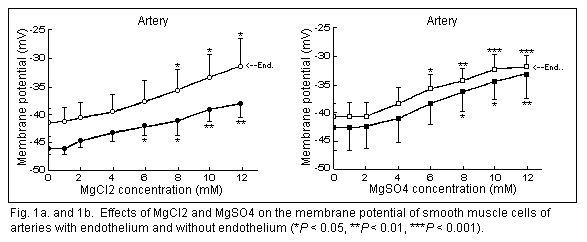Current Research in magnesium, edited by M.J. Halpern
and J. Durlach
©1996 John Libbey & Company Ltd./7th Intemational
Magnesium Symposium, pp. 197-198.
Chapter 45
Contribution to the physiology of the human placental vessels:
effects of Mg2+ on membrane potential of smooth muscle
cell vessels
1B. Ibrahim, 1A. Guiet-Bara,
2J. Leveteau, 1J.C. Challier,
1C. Vervelle, 3J. Durlach and
1M. Bara
1Laboratoire de Physiopathogie du
Développement, Université P.M. Curie, 4 Place
Jussieu 75252-Paris Cedex 05, France;
2Neurophysiologie comparée, Université
P.M. Curie, France; 3SDRM, Hôpital
Saint-Vincent-de-Paul, France
Introduction
A wide range of data has
been collected concerning the effect of extracellular magnesium
ions on the blood vessel smooth muscle tone and reactivity. The
aim of the present study was to contribute to the physiology of
the human placental vessels, investigating the influence of
magnesium ions (MgCl2 and MgSO4) on
membrane potential of the smooth muscle cells of the human
placental chorionic arteries with endothelium and without
endothelium (endothelium-free).
Material and methods
Short segments (about 10 mm long) of human chorionic placental
arteries were carefully dissected after delivery from 12 normal
term vaginal deliveries. The preparations were left to
equilibrate for 60 min in Earle's solution (37±1°C)
and bubbled with carbogen (95 per cent O2 - 5 per cent
CO2; the final pH was 7.4 ± 0.05). Recordings
of membrane potential of the arterial smooth muscle cells was
made using glass microelectronics (KCl 3M).
Results are expressed as means ± SD. The data
statistical processing was made with the one way analysis of
variance test (ANOVA), the Tukey-Kramer multiple comparisons test
and the Student test. P values from 0.05 were considered
significant.
Results
Effects Of MgCl2 and
MgSO4 on the membrane potential
(a) Arteries with endothelium
The addition of MgCl2 elicited a significant
depolarization of the smooth muscle cell membrane from 8 mM
(P < 0.05). An identical effect was observed with
MgSO4 from 6 mM (P < 0.05).
(b) Endothelium-free arteries
A significant depolarization of the smooth muscle cell membrane
was observed with MgCl2 from 6 mM (P <
0.05) and with MgSO4 from 8 mM (P <
0.05).
Discussion
The results show that the magnesium ions associated with
Cl- or with SO42- exert a direct
contribution to the membrane potential and certainly, regulate
the viability of the K+ channels implicated in the
origin of the membrane potential1. These data suggest
that the importance of thedepolarizing effect of Mg2+
seem to be mediated through the endothelium since the
depolarization thresholds are different in arteries with
endothelium and in endothelium-free arteries. Endothelial cells
exert a protective effect towards MgCl2 compared to
MgSO4. The endothelial cells seem act as an
intermediate between the Mg2+ ions and the membrane of
the smooth muscle cells. In the endothelial cells, two mechanisms
may be involved: (1) outside Mg2+ ions exert important
effects on the precise location and concentration of internal
Ca2+ and Mg2+ which affect the tone in the
vascular smooth muscle cells2 ; (2) the depolarizing
effect due to a lower concentration of MgSO4 may be
the consequence of endothelial secretion. Indeed, the vascular
endothelium plays a functional role in modulating the tone of
underlying smooth muscle by releasing relaxing factors such as
nitric oxide and prostacyclin or constricting factors such as
endothelin3. The effect of MgCl2 is as
follows: the high depolarization threshold indicates a protective
role of endothelial cells towards smooth muscle cells. What is
the mechanism? Mgi variation, Mg2+
uptake?
In endothelium-free arteries, MgSO4 has a direct
effect on the smooth muscle cell membrane potential, but at high
concentrations, since there is not secretion of various factors
by the endothelial cells. On the other hand, MgCl2
interferes directly with the smooth cell membrane and the
depolarization threshold is lower. The depolarization of the
vascular smooth muscle cells implicates a vasoconstrictor effect.
in vivo, in preeclampsia, MgSO4 has a
vasodilator action4 . Our studies indicate that the
addition of MgCl2 and MgSO4 has a possible
vasoconstrictor action on the human placental arterial smooth
muscle cells and reveal the important role of the endothelial
cells.

References
I . Bara, M. & Guiet-Bara, A. (1993): Magnesium effect on
the membrane potential of smooth muscle cells of human placental
chorionic vessels. Magnes. Res. 6,
329-331.
2. Adams, D.J. (1994): Ionic channels in vascular endothelial
cells. Trends Cardiovasc. Med. 4,
18-26.
3. Yanagisawa, M., Kurihara, H., Kimura, S., Tonnobe, Y.,
Kobayashi, M., Mitsui, Y., Yasaki, Y., Goto, K. & Masaki, T.
(1988): A novel potent vasoconstrictor peptide produced by
vascular endothelial cells. Nature 332,
411-415.
4. Andrews, W.W., Gant, N.F. & Magness, R.R. (1994):
Effect of magnesium sulfate on eicosanoid levels in women with
pregnancy-induced hypertension. Hypertens. Pregnancy
13, 71-82.
All articles by Dr. Durlach are copyrighted, and permission is
granted to Web users only to make single hard copies for personal
use. Additional reprints should be obtained from the originating
journals. Excerpts may be used by the media with attribution to
Dr. Durlach.
This page was first uploaded to The Magnesium Web Site on
August 11, 1997
http://www.mgwater.com/

